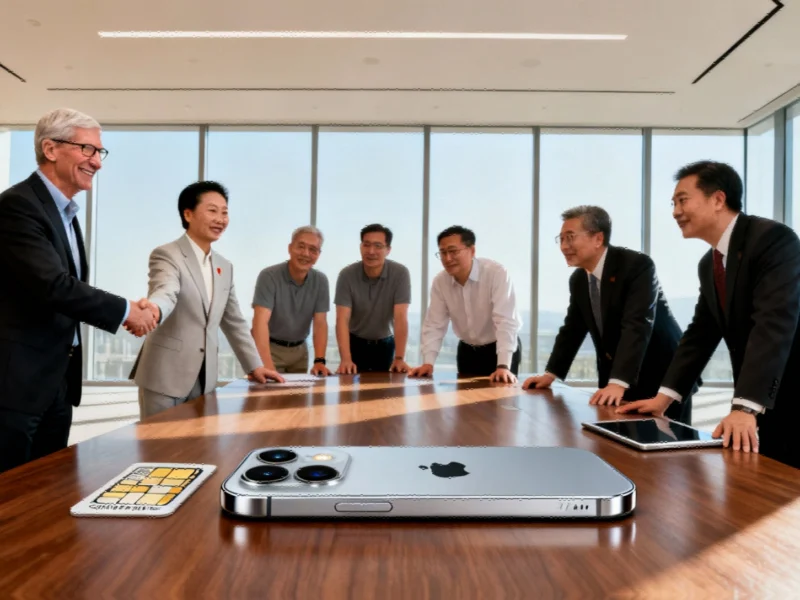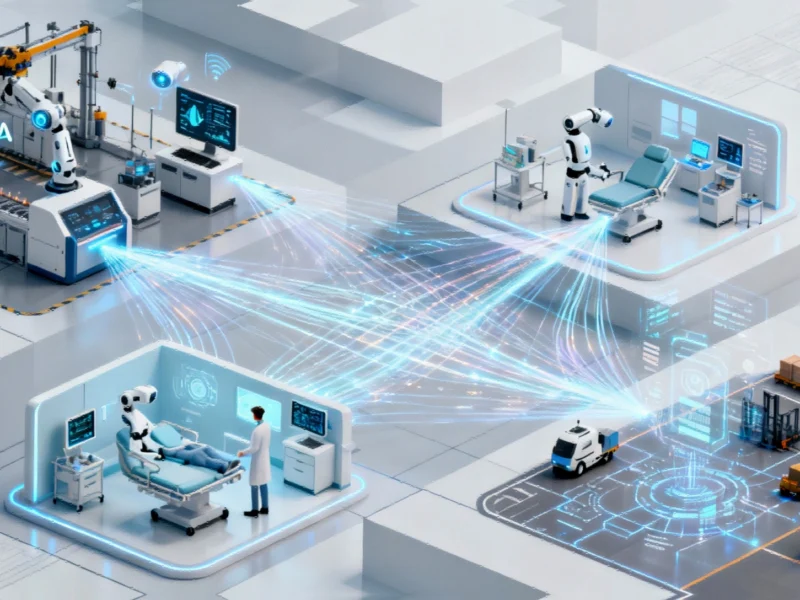TITLE: Apple Secures Chinese Government Backing as Cook Navigates US-China Manufacturing Dilemma
In a significant development for global tech manufacturing, Apple has received strong backing from the Chinese government for its continued operations in the country during CEO Tim Cook’s recent high-profile visit. This endorsement comes at a crucial time when Apple faces increasing pressure to balance manufacturing between China’s established supply chains and growing demands for US domestic production.
Cook’s meeting with Chinese Minister of Industry and Information Technology Li Lecheng on Wednesday resulted in commitments to deepen cooperation and increase investments in China, signaling a strategic move to maintain Apple’s significant manufacturing presence in the region. The timing is particularly noteworthy as companies worldwide are reevaluating their supply chain strategies amid evolving trade policies, similar to how New York recently enacted groundbreaking regulations affecting technology deployment and development.
Manufacturing Tightrope: China’s Scale vs US Demands
Apple’s manufacturing strategy represents one of the most complex balancing acts in global technology. While the company has pledged $600 billion in US investments to support domestic silicon supply chains, China’s unparalleled manufacturing ecosystem continues to provide economies of scale that remain difficult to replicate elsewhere. This expansion of US investment commitments from an initial $500 billion came partially in response to former President Trump’s punitive tariffs on India, highlighting how geopolitical factors directly influence corporate manufacturing decisions.
The challenge was evident when Apple attempted to shift iPhone production to India, only to face capacity limitations that may still require shipping up to 9 million iPhone units from China to the US in FY 2026. This manufacturing reality underscores why Cook continues to emphasize Apple’s commitment to China, stating during his visit: “I always want to come back [to China]. There’s always so much change. It’s so dynamic. I love the Chinese people and culture and it’s wonderful to be in Shanghai.”
Supply Chain Developments and Technical Innovations
Concurrent with Cook’s high-level meetings, Apple’s Chief Operating Officer Sabih Khan visited Lens Precision facilities in Taizhou, a subsidiary of Lens Technology that already supplies components for multiple Apple products. This visit gains significance as the iPhone 18’s advanced camera system creates ripples across the supply chain, involving major players like Samsung Electronics, its subsidiary SEMES, Japan’s ADVANTEST and INTER ACTION, and South Korea’s Doosan Tesna.
These technical developments parallel innovations seen across the industry, where companies are pushing hardware capabilities to new levels. For instance, recent motherboard advancements have demonstrated how budget components can achieve remarkable performance, while the emergence of new computing form factors continues to reshape product categories.
Diversification Efforts and Geopolitical Vulnerabilities
Apple’s strategy includes significant diversification beyond China, with plans to manufacture upcoming home devices in Vietnam using BYD’s manufacturing facilities. These products reportedly include a HomePod with a 7-inch screen, security cameras, and a dedicated tabletop AI robot. However, this approach carries its own vulnerabilities, as demonstrated by the potential for sudden policy changes that could disrupt carefully laid plans.
The company’s situation reflects broader industry trends where technology firms must navigate complex regulatory environments while advancing their technical capabilities. This challenge mirrors how major tech companies are responding to competitive moves in various market segments, and how AI developers are creating more adaptable systems to meet diverse user needs.
Regulatory Resolution and Future Outlook
Cook’s visit successfully resolved regulatory hurdles that had hampered the launch of the eSIM-only Apple iPhone 17 Air in China, removing a significant barrier to Apple’s product rollout in one of its most important markets. This achievement demonstrates the importance of maintaining strong government relationships in key operating regions.
The broader context of Apple’s positioning reflects how energy and infrastructure considerations are becoming increasingly important for tech companies, similar to how other technology giants are exploring advanced energy solutions to power their future operations.
Looking ahead, Apple’s ability to maintain this delicate balance between US and Chinese interests will depend on continued diplomatic engagement, strategic investment allocations, and maintaining the flexibility to adapt to sudden geopolitical shifts. With both governments viewing technology manufacturing as strategically vital, Cook’s challenge remains ensuring Apple can leverage China’s manufacturing capabilities while satisfying US domestic production expectations—all while preparing for potential disruptions that could emerge from either direction.
Based on reporting by {‘uri’: ‘wccftech.com’, ‘dataType’: ‘news’, ‘title’: ‘Wccftech’, ‘description’: ‘We bring you the latest from hardware, mobile technology and gaming industries in news, reviews, guides and more.’, ‘location’: {‘type’: ‘country’, ‘geoNamesId’: ‘6252001’, ‘label’: {‘eng’: ‘United States’}, ‘population’: 310232863, ‘lat’: 39.76, ‘long’: -98.5, ‘area’: 9629091, ‘continent’: ‘Noth America’}, ‘locationValidated’: False, ‘ranking’: {‘importanceRank’: 211894, ‘alexaGlobalRank’: 5765, ‘alexaCountryRank’: 3681}}. This article aggregates information from publicly available sources. All trademarks and copyrights belong to their respective owners.



